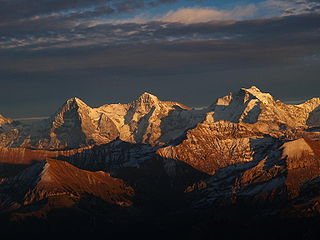
The Bernese Alps are a mountain range of the Alps, located in western Switzerland. Although the name suggests that they are located in the Berner Oberland region of the canton of Bern, portions of the Bernese Alps are in the adjacent cantons of Valais, Fribourg and Vaud, the latter being usually named Fribourg Alps and Vaud Alps respectively. The highest mountain in the range, the Finsteraarhorn, is also the highest point in the canton of Bern.
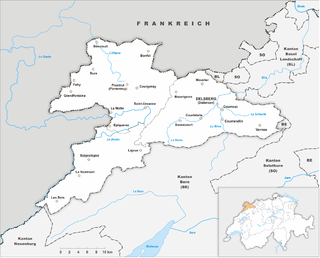
The Republic and Canton of Jura, less formally the Canton of Jura or Canton Jura, is the newest of the 26 Swiss cantons, located in the northwestern part of Switzerland. The capital is Delémont. It shares borders with the canton of Basel-Landschaft, the canton of Bern, the canton of Neuchatel, the canton of Solothurn, and the French régions of Bourgogne-Franche-Comté and Grand Est.

The canton of Bern or Berne is one of the 26 cantons forming the Swiss Confederation. Its capital city, Bern, is also the de facto capital of Switzerland. The bear is the heraldic symbol of the canton, displayed on a red-yellow background.
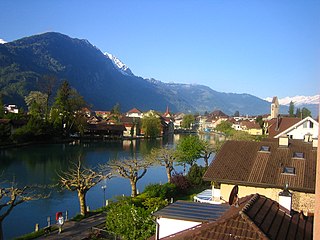
Interlaken is a Swiss town and municipality in the Interlaken-Oberhasli administrative district in the canton of Bern. It is an important and well-known tourist destination in the Bernese Oberland region of the Swiss Alps, and the main transport gateway to the mountains and lakes of that region.

The Bernese Oberland, the highest and southernmost part of the canton of Bern, is one of the canton's five administrative regions. It constitutes the Alpine region of the canton and the northern side of the Bernese Alps, including many of its highest peaks, among which the Finsteraarhorn, the highest in both range and canton.

The stone put is one of the main Scottish heavy athletic events at modern-day Highland games gatherings. While similar to the shot put, the stone put more frequently uses an ordinary stone or rock instead of a steel ball. The weight of the stone will vary from 16 to 26 lb for men depending on which type of stone put event is being contested and also on the idiosyncrasies of the event. There are also some differences in allowable techniques and rules.

The Grand Council is the parliament of the Swiss canton of Bern.

Wilderswil is a village and a municipality in the Interlaken-Oberhasli administrative district in the canton of Bern in Switzerland.
Saxeten is a municipality in the Interlaken-Oberhasli administrative district in the canton of Bern in Switzerland.

Matten bei Interlaken is a village and municipality in the Interlaken-Oberhasli administrative district in the canton of Bern in Switzerland.

The Oberhasli is a historical Landvogtei or Talschaft in the Bernese Highlands, Switzerland, bordering on the cantons of Obwalden (OW), Nidwalden (NW), Uri (UR) and Wallis (VS).

Seeland is a region in Switzerland, at the south-eastern foot of the mountain range of the Jura Mountains containing the 3 Lakes of Morat, Neuchâtel, and Bienne (Biel). In previous eras, it was the floodplain of the Aare and was thus swampy. After the huge hydrological works Jura water correction, the area drained out and could support more cultivation. Seeland is one of the most important regions in Switzerland for growing vegetables, particularly in the Grand Marais.
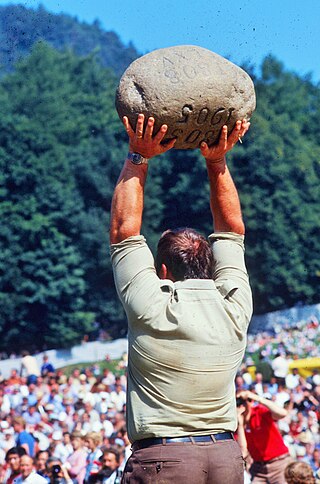
Steinstossen is the Swiss variant of stone put, a competition in throwing a heavy stone. Practiced among the alpine population since prehistoric times, it is recorded to have taken place in Basel in the 13th century. During the 15th century, it is frequently recorded to have been practiced alongside the Schützenfeste of the Old Swiss Confederacy. It is also central to the Unspunnenfest, first held in 1805, with its symbol the 83.5 kg Unspunnenstein.

The Gerechtigkeitsbrunnen is a 16th-century fountain in the Gerechtigkeitsgasse in the Old City of Bern, Switzerland. It is the only Bernese fountain to retain all original design elements, and is listed as a cultural heritage of national significance.
This local electoral calendar for the year 2010 lists the subnational elections held in 2010 in the de jure and de facto sovereign states. By-elections and sub-national referendums are also included.

Unspunnen Castle is a castle, now in ruins, located in the municipality of Wilderswil in the Bernese Highlands of Switzerland. The castle, likely constructed in the early 12th century, overlooks the city of Interlaken.

Jura separatism is a regionalist autonomist movement in the Bernese Jura of Switzerland.
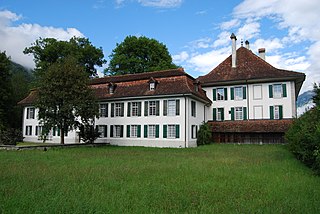
Interlaken Monastery was a convent of the Augustinian Canons Regular from about 1133 until 1528 at Interlaken in the canton of Bern in Switzerland. It is a Swiss heritage site of national significance.

The Bernese Jura Railway was a railway company in Switzerland. The company was called the Jura–Bern–Luzern from 1 July 1884. The Jura–Bern–Lucerne merged with the Western Switzerland–Simplon Railways to form the Jura–Simplon Railway (Jura-Simplon-Bahn), JS) on 1 January 1890.

Shawne Fielding is an American-Swiss actress and model who has appeared in US, German, and Swiss television series and movies. Notably, Fielding had been married to Thomas Borer, former Swiss Ambassador to Germany, and twice to American billionaire Charles Addison Williams of Sammons Enterprises, her current husband again.




















